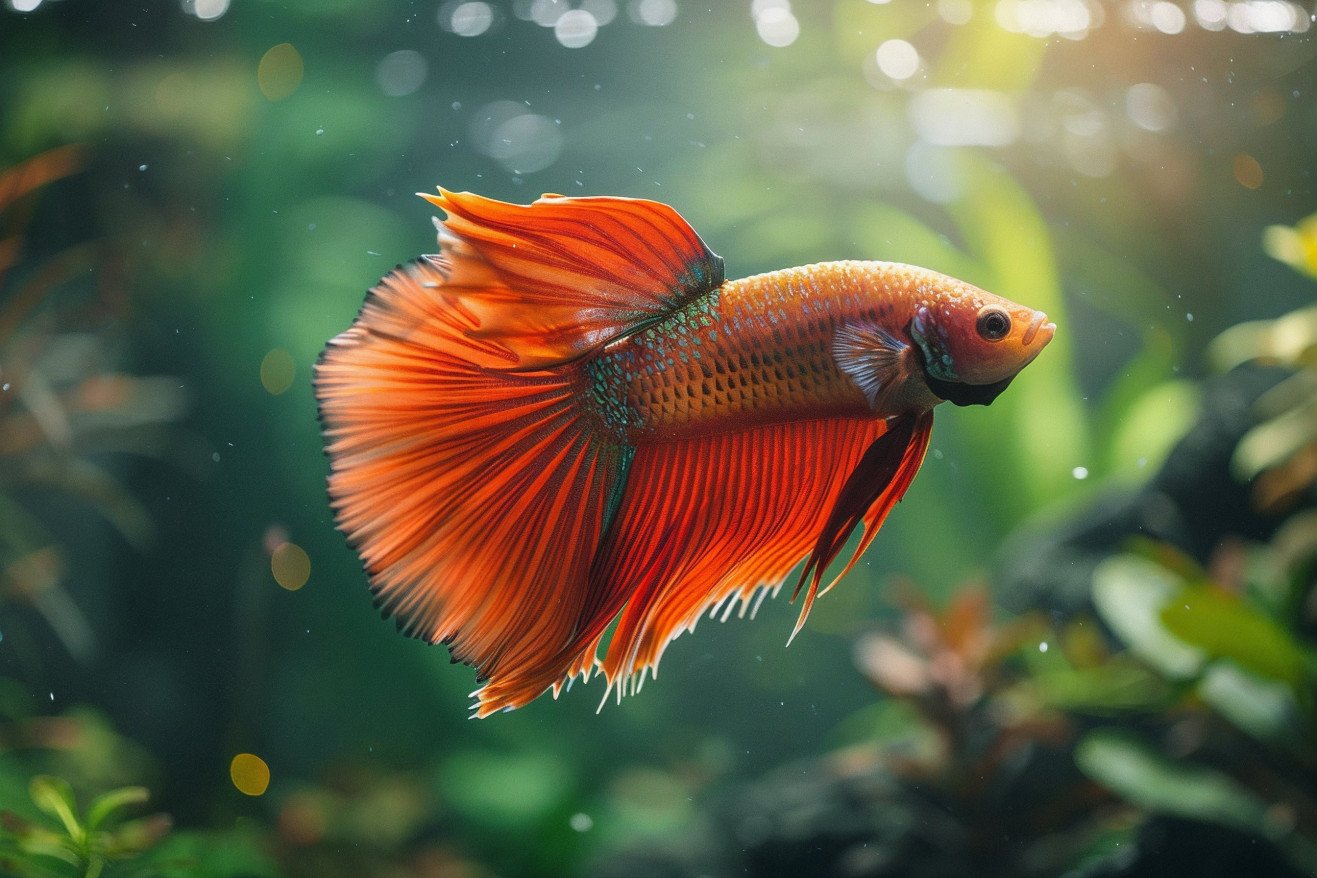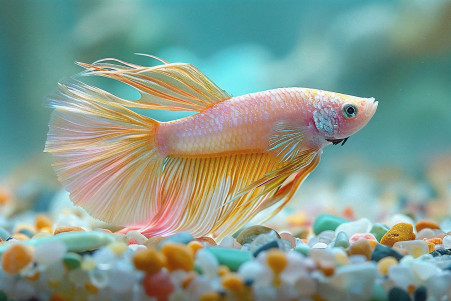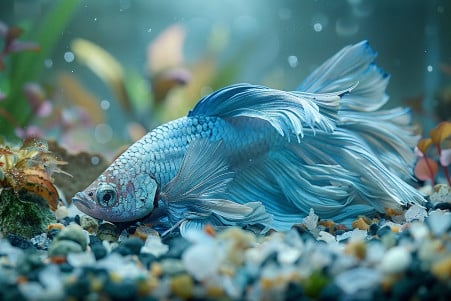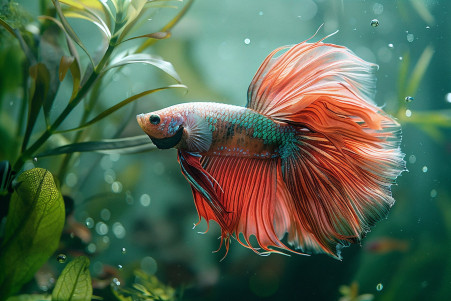Why Is My Betta Fish Always at the Top of the Tank? Unveiling Aquatic Habits
20 April 2024 • Updated 19 April 2024

There are a number of things that could be causing your betta fish to hang out at the top of the tank, including water quality issues, tank setup, and even natural behaviors. One of the most common reasons betta fish are found at the top of the tank is that they are breathing air. Bettas are labyrinth fish, which means they have a special organ that allows them to breathe air. That said, hanging out at the surface for long periods of time can also be a sign of poor water quality, including low oxygen levels, high ammonia, and temperature issues, all of which can cause stress to the fish.
Below, we'll take a deep dive into the research on bettas' natural habitat requirements, natural behaviors, and potential health issues that may be causing them to hang out at the top of the tank. By learning more about the root causes, you can make sure you're providing the best environment and looking out for your betta fish's health.
Why does my betta fish stay at the top of the tank?
Ideal Water Parameters for Betta Fish
Water quality is one of the most important factors in keeping betta fish healthy and happy. As noted by Betta Fish Bay, straying too far from the ideal water parameters can lead to issues for your betta. Modest Fish suggests that you aim for ammonia and nitrite levels of 0 ppm, nitrate levels below 20 ppm, a pH between 6.5-7.5, general hardness (GH) of 3-4 dGH (50-66.7 ppm), and carbonate hardness (KH) of 3-5 dKH (53.6-89.4 ppm).
The ideal temperature range is 75°-81°F (23.8°-27.2°C) according to Modest Fish. PetMD notes that you should use an aquarium heater and thermometer to maintain a consistent water temperature between 72-82°F. Fluctuations in temperature can lead to a variety of health problems.
Glass Aqua notes the importance of the nitrogen cycle, which is when beneficial bacteria in the tank convert toxic ammonia into nitrites and then nitrates. Both ammonia and nitrites can burn the gills of fish, so new tanks need to be "cycled" to build up these colonies of bacteria before bettas are added.
It's important to test your water parameters regularly using an aquarium test kit. Betta Boxx suggests using dechlorinators, pH buffers like crushed coral or sphagnum moss, and aging water before adding it to the tank. You should also perform partial (10-25%) water changes every 2-4 weeks to ensure that your water parameters stay within the ideal ranges. This will also help prevent issues like surface hanging that can be caused by poor water quality.
How to Tell If Your Betta Fish Is Stressed and How to Help
Stress can have a big impact on the health and well-being of betta fish. According to The Aquarium Life, some of the most common signs of a stressed betta are lethargy, loss of appetite, dull color, clamped fins, and erratic swimming. Hepper notes that the most common causes of stress in bettas are poor water quality, lack of hiding places, incompatible tank mates, temperature changes, and other environmental stressors.
Chronic stress can lead to a shorter life and a lower quality of life for bettas. The Aquarium Life even goes so far as to say that if stress is left untreated, it can lead to serious health problems and death. To help reduce stress, Chewy recommends maintaining consistent water quality by performing regular partial water changes, using water conditioners, and making sure your betta has plenty of places to hide. Hepper also says that bettas can be treated with medications like Seachem StressGuard or API StressCoat to help them recover from stress-related issues.
By learning to recognize the signs of stress and taking steps to ensure that your betta is living in a safe, enriching environment, you can help make sure that your betta fish is as healthy and happy as possible.
Tank Mates for Betta Fish
Selecting the right tank mates is important to ensure your betta fish can live in a healthy, stress-free environment. According to Aqueon, some of the best tank mates for bettas are peaceful, community fish like corydoras catfish, tetras, and rasboras. These fish are less likely to bother the betta and will also occupy different areas of the tank, so there's less competition.
Bettafish.org suggests that if you're keeping bettas with other fish, the tank should be at least 10 gallons in size. This will help ensure that the tank is not overstocked and that the betta has plenty of room to establish its territory. In general, no matter the size of the tank, make sure it's heavily planted and decorated, with lots of hiding spots. This will help the betta feel more secure and less stressed.
When you're adding new fish to the tank, Aquarium Co-Op recommends a long acclimation period and close observation for the first 72 hours. This will help make sure the fish are compatible and that the betta has time to get used to the new tank mates. It's also important to avoid aggressive fish and fish with long fins, as these are more likely to be targeted by the betta.
By choosing tank mates carefully and making sure the tank is set up in a way that will keep the betta stress-free, you can help ensure that your betta is healthy and happy and less likely to engage in surface hanging.
What Is Swim Bladder Disease?
Swim bladder disease is a common issue that can affect a betta's ability to control its buoyancy and swim properly. As noted by Betta Boxx, the swim bladder is an air-filled organ that helps fish regulate their ability to float and sink. When the swim bladder is compromised, it can lead to a number of swimming problems.
Some of the signs of swim bladder disease in bettas include floating at the top of the tank, sinking to the bottom, swimming sideways or upside down, and having difficulty controlling their movement. Bettafish.org notes that the most common causes of swim bladder disease are overeating, constipation, cold water that slows down digestion, bacterial or parasitic infections, and physical injury.
Swim bladder disease can be treated by fasting the betta for 2-3 days, raising the water temperature to between 78-80°F, and feeding the fish cooked, peeled peas, according to The Spruce Pets. If an infection is to blame, antibiotics may be necessary. Hygger also recommends using aquarium salt as a supportive treatment.
The best way to prevent swim bladder disease is to make sure your betta is getting the best care possible, which includes maintaining the right water conditions, not overfeeding, and minimizing stress. By knowing what to look out for and taking steps to prevent the disease, you can make sure your betta's swim bladder stays healthy and they can move around their tank with ease.
Creating an Enriched Environment
Creating an enriched environment is important for both the physical and mental health of betta fish. As noted by Betta Fish Forum, bettas do best in tanks that are heavily planted and have driftwood, caves, and other decorations that provide hiding places and breaks in the line of sight. Modest Fish even recommends a tank that's at least 10 gallons so that it can be properly filtered and heated.
Using an aquarium heater and thermometer to maintain a consistent water temperature between 72-82°F, as suggested by PetMD, can help ensure that the environment is comfortable. In addition, PetMD recommends doing regular partial water changes to make sure that the water's pH, ammonia, and nitrate levels stay within the proper ranges.
To keep your betta mentally engaged, Betta Fish Forum recommends changing up the decorations in the tank or using feeding puzzles. An enriched environment can help lower stress and promote more natural betta behaviors, which can lead to a healthier, happier fish.
Conclusion: How to Keep Your Betta Healthy and Happy
The best way to figure out why your betta fish is staying at the top of the tank is to address the underlying causes, which can include everything from water quality and stress to swim bladder disease. In order to make sure your betta is healthy and happy, it's important to provide the right environment, including the right water parameters, and to make sure that you're not exposing your betta to unnecessary stress or incompatible tank mates.
By paying close attention to your betta's behavior and making changes when necessary, you can make sure that your betta is living in an environment that is enriching and free of stress. After all, a healthy, happy betta is one that can swim freely throughout its tank without feeling the need to stay at the surface.


